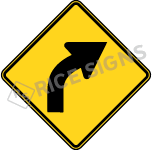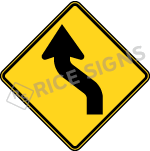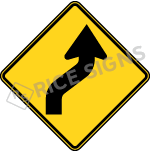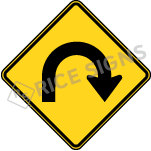About Curve Signs
What are Curve Signs?
Curve Signs are yellow, diamond-shaped warning signs that let drivers know there is an upcoming curve, bend, or turn in the road. Slowing down ahead of a curve is necessary for safe passage. Most Curve Signs have two variations where the directional arrow either points Right or points Left. This category includes several styles of what the MUTCD calls “Horizontal Alignment Warning Signs” as well as their supporting placards.
What supporting Placards are often seen with Curve Signs?
Advisory Speed Limit (W13-1P) and Distance Warning Placards are the two most common Placards used alongside Curve Signs. Advisory Speed Limit Placards inform drivers of a situation where a drop in traveling speed will soon occur. One Next XX Miles Placard can be paired with one Winding Road Sign to inform drivers that roads will curve or bend for a specific distance ahead. For more information on how speed limits are determined in conjunction with curve warning signs, see the Federal Highway Administration Publication FHWA-SA-11-22. Additionally, engineering studies or engineering judgment are used in the placement of all warning signs.
Are Curve Signs customizable?
Yes, in just a few cases. For supporting Placards, the speed limit on Advisory Speed Limit Placards and the number of miles on Next XX Miles Placards can be customized. For a given diamond-shaped Curve Sign, the curve or turn symbol is allowed to be slightly modified to better represent the intersection geometry of an upcoming curve. As a whole, the MUTCD refers to these types of signs as “Combination Horizontal Alignment/Intersection Signs”. The customization guidance is located in Paragraph 08 of Chapter 2C, Section 2C.02.
What additional safety practice can be employed to help road users see signs and posts at night?
The Federal Highway Administration allows for a strip of reflective material to be used on the curve warning sign post. The strip of retroreflective material shall be at least 2 inches wide and should extend the full length of the sign post. The color of the strip should match the color of the sheeting on the warning sign. The purpose is to make the post and sign more visible to motorists. Although limited studies have been done on the effectiveness of reflective posts, the FHA says that they can help lead to moderate reductions in the mean and 85th percentile operating speeds in curves (Hallmark et al., 2012).
Selecting a Curve Sign
Which size should I choose for diamond-shaped Curve Signs?
36”x36” Curve Signs appear in multi-lane roadways, highways, and interstates. 48”x48” Curve Signs are considered oversized, but are often considered when additional sign visibility is needed. 30”x30” Curve Signs are only approved for use on single-lane roadways.
What size Chevron Alignment Sign is best for my project?
18”x24” Chevron Alignment Signs are used on single-lane, multi-lane, and highway roads. The larger sign sizes, 30”x36” and 36”x48”, are reserved for interstate use.
Do I need a Curve Sign or a Turn Sign, and how are they different?
To choose between a Curve Sign or a Turn Sign, two primary factors must be considered: the number of curves in the road and the traveling speed of the roadway.
- For roads with one curve or bend, when the curve speed limit is 30 mph or less, use a Turn Sign. When the curve speed limit is above 30 mph, use a Curve Sign.
- For roads with two curves, use one Reverse Curve Sign instead of multiple Curve Signs. Similarly, use only one Reverse Turn Sign when there are two turns in the road.
- When a road has three or more curves or bends, use a Winding Road Sign.
Sharpness of the Curve Table
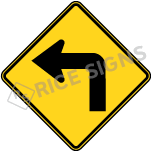 A W1-1 turn sign should be used before a horizontal curve with speed limit of 30 mph or less.
A W1-1 turn sign should be used before a horizontal curve with speed limit of 30 mph or less.
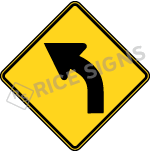 A W1-2 turn sign may be used before a horizontal curve with speed limit of 30 mph or greater.
A W1-2 turn sign may be used before a horizontal curve with speed limit of 30 mph or greater.
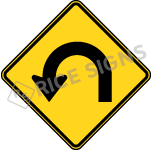 May be used where a curve has a change of 135 degrees or more
May be used where a curve has a change of 135 degrees or more
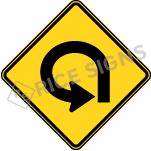 May be used where a curve has a change of 270 degrees or more
May be used where a curve has a change of 270 degrees or more
What is the difference between an Advisory Speed Limit Placard and a traditional Speed Limit Sign?
Advisory Speed Limit Placards and Speed Limit Signs differ in appearance and function. Advisory Speed Limit Placards are yellow, square-shaped supporting placards that notify drivers of a temporary speed limit reduction on a curve. Traditional Speed Limit Signs communicate the speed limit of a road in most circumstances. Speed Limit Signs often appear after Curve Signs to remind drivers of the regular roadway travel speed.
Mounting Curve Signs
How are Curve Signs mounted?
For diamond-shaped Curve Signs, 36”x36” signs have two pre-drilled holes and can be mounted on one round, square, or U-channel post. 48”x48” diamond-shaped signs have four pre-drilled holes and require two standard sign mounting posts. 30”x30” Curve Signs can also be mounted with one standard post. To mount Chevron Signs, use our H-150 Chevron Adjustable Bracket Kit
Should I mount a Speed Limit Warning Placard above or below a Curve Sign?
An Advisory Speed Limit Placard should always be mounted directly below a Curve Sign, even if other placards are being used.
Materials, Orders & Shipping
What materials are Curve Signs manufactured with?
We use rust-proof .080” aluminum to manufacture our Curve Signs. Standard Curve Signs are manufactured with yellow high-intensity prismatic sheeting to meet or exceed MUTCD standards, but we also manufacture signs with fluorescent yellow full-cube sheeting for additional visibility. The relative cost of curve signs increases with the larger sizes and higher grades of reflective material, including the fluorescent colors.
How does ordering and shipping work?
Ordering is as simple as adding the items to your shopping cart and checking out. Many of our customers have commented in the reviews that the process is quick and easy. After your order ships, you will receive an email with the UPS tracking number so you can see the exact day of delivery.
How will my order be packaged?
Curve Signs arrive in a flat box covered with slip sheeting, a material we use to protect the face of the sign during shipment.
Is mounting hardware included with my purchase?
Although mounting hardware isn’t included, everything you need can be found across our sign mounting hardware pages.
More Information
What factors should I consider when I choose a Curve Sign?
The MUTCD provides guidance on Horizontal Alignment Signs, a category that includes Curve Signs. Paragraph 04 of Chapter 2C, Section 2C.05 outlines nine roadway factors to consider when selecting a Horizontal Alignment Sign. One of those factors, the AADT, influences whether or not to use Horizontal Alignment Signs on a given roadway. AADT, or annual average daily traffic, is a measure of traffic volume that is determined by road engineers.
Where can I find more information about Curve Signs?
Because the MUTCD considers Curve Signs to be a type of Horizontal Alignment Sign, more information about Curve Signs can be found under the “Horizontal Alignment Warning Signs and Plaques” heading in Chapter 2C of the MUTCD.
 A W1-1 turn sign should be used before a horizontal curve with speed limit of 30 mph or less.
A W1-1 turn sign should be used before a horizontal curve with speed limit of 30 mph or less.
 A W1-2 turn sign may be used before a horizontal curve with speed limit of 30 mph or greater.
A W1-2 turn sign may be used before a horizontal curve with speed limit of 30 mph or greater.
 May be used where a curve has a change of 135 degrees or more
May be used where a curve has a change of 135 degrees or more
 May be used where a curve has a change of 270 degrees or more
May be used where a curve has a change of 270 degrees or more
